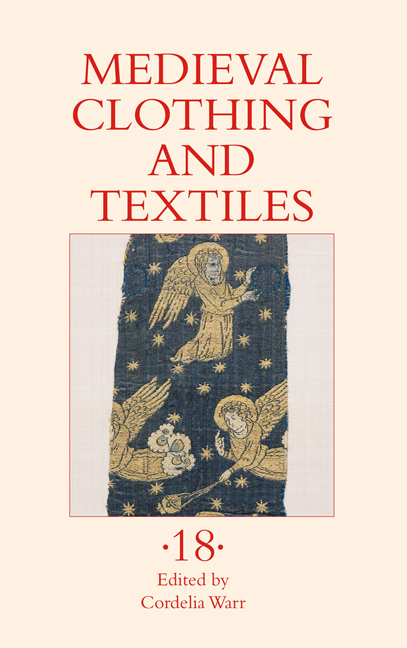Book contents
- Frontmatter
- Contents
- Illustrations
- Tables
- Contributors
- Preface
- 1 Linen Armour in the Frankish Countries: The Twelfth Century
- 2 Serial Production and Individualisation in Late Medieval Silk Weaving
- 3 The Trousseau of Isabella Bruce, Queen of Norway (The National Archives, Kew, DL 25/83)
- 4 Make and Create: The Craftswomen in the Salone Frescoes of the Palazzo della Ragione, Padua
- 5 Combs, Mirrors, and Other Female Beauty Bling in the Later Middle Ages
- 6 The Dividing Lines of Social Status in Sixteenth-Century Scottish Fashion
- Recent Books of Interest
- Author Index, Volumes 1–17
4 - Make and Create: The Craftswomen in the Salone Frescoes of the Palazzo della Ragione, Padua
Published online by Cambridge University Press: 10 May 2024
- Frontmatter
- Contents
- Illustrations
- Tables
- Contributors
- Preface
- 1 Linen Armour in the Frankish Countries: The Twelfth Century
- 2 Serial Production and Individualisation in Late Medieval Silk Weaving
- 3 The Trousseau of Isabella Bruce, Queen of Norway (The National Archives, Kew, DL 25/83)
- 4 Make and Create: The Craftswomen in the Salone Frescoes of the Palazzo della Ragione, Padua
- 5 Combs, Mirrors, and Other Female Beauty Bling in the Later Middle Ages
- 6 The Dividing Lines of Social Status in Sixteenth-Century Scottish Fashion
- Recent Books of Interest
- Author Index, Volumes 1–17
Summary
The first-floor Salone of Padua's first civic public building, the Palazzo della Ragione (fig. 4.1), the Palace of Reason, contains a medieval fresco scheme full of complex imagery: trades and skills exemplified by the medieval Paduan workforce, sky constellations, images of the zodiac signs and the planets, a rich assembly of labours associated with each month and season in the tradition of the Labours of the Months, as well as theological and liturgical themes. The scheme is located at the top of the wall where it meets the great wooden whaleback roof and forms a continuous clockwise seasonal narrative painted across three registers and across all four walls (fig. 4.2). While women are represented gathering flowers, accepting marriage proposals, playing musical instruments, or in religious roles, when it comes to trades and labour men take precedence. They harvest wheat, bake bread, and gather grapes. The apothecary, physician, barber-surgeon, and medical astrologer heal the ill when summer heat brings fevers. The skinners and tanners, boatbuilders and stonemasons, knife grinders, boat repairers, and carpenters maintain the material infrastructure of medieval life. Yet winning their place in a scheme where every image was important are seven women busily engaged in crafts which are rarely, if at all, depicted in medieval mural decorations—spinning, sewing, knitting, and making cord. This article focuses on the crafts of these women and their importance in late medieval Padua.
The Palazzo della Ragione, situated in the main square of Padua, has survived for over eight hundred years. However, the building has been altered and the fresco scheme has twice suffered damage. Hence I begin this paper by examining the genesis of the building, the painter and workshop that created the fresco scheme, and the restoration history of the images in order to gain a better understanding of their original appearance. I then focus on the fresco scheme images themselves and the crafts depicted within the frescoes, both functionally and metaphorically. I take into account the position of the craftswomen in the scheme, their clothing, and the work that they undertake.
- Type
- Chapter
- Information
- Medieval Clothing and Textiles , pp. 99 - 128Publisher: Boydell & BrewerPrint publication year: 2024

